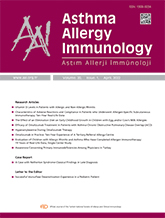


Objective: To evaluate the clinical outcome of omalizumab in various diseases.
Materials and Methods: Patients receiving at least one dose of omalizumab for chronic spontaneous urticaria (CSU), severe allergic asthma (SAA), nasal polyposis (NP) with asthma, idiopathic anaphylaxis (IA), mastocytosis, or allergic bronchopulmonary aspergillosis (ABPA) were retrospectively included. The effectiveness of omalizumab was assessed with asthma control test (ACT) at baseline and 16th week of treatment in SAA and ABPA. Urticaria activity score-7 (UAS7) and medication scores (MS) in CSU and SCORMA (SCORing MAstocytosis) index in mastocytosis were determined at baseline, the 3rd and 6th months of treatment. Nasal endoscopy for NP was performed at baseline and at the 6th month and first year of treatment. Clinical assessments at baseline and during treatment were performed for IA.
Results: A total of 213 patients were included. In 59 patients with SAA (27.6%), ACT scores significantly increased at the 16th week (p<0.001). Omalizumab was discontinued at a median duration of 15 months (min-max: 6-111) in 10 (16.9%) patients whose asthma was under control. In 4 of them, omalizumab had to be restarted at a median of 6 (min-max:3-12) months. In 141 patients with CSU, the baseline UAS7 and MS were significantly higher than those at the 3rd and 6th months (p<0.001). The treatment interval was increased to 45 days at the 6th month in 77 (55.8%) patients and 40 of them presented with relapse in a mean duration of 37.98±2.3 days. Five patients with ABPA, 4 patients with IA and 2 patients with NP and asthma were under control at their assessment visits. In 2 patients with mastocytosis, the SCORMA index was significantly lower at the 6th month (p=0.04). Thrombocytopenia and anaphylaxis were the confirmed adverse reactions seen during treatment.
Conclusion: This study demonstrates the effectiveness and safety of omalizumab in various diseases in long-term use in a real-life practice.